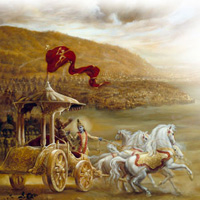The Pursuit of Eternal Happiness Teachings From the Bhagwad Gita
In the different yogas or chapters of the most exalted Hindu scripture, the Bhagwad Gita, Lord Krishna, a Vishnu incarnate, Himself extols the virtues and character that makes an individual transcend to the divine. In perhaps the most fitting end, He focuses on the attainment of eternal happiness, or the path to salvation. The eighteenth chapter of the Bhagwad Gita is among the most relevant to us, whether today or in the days to come.
In verses 36 – 40, the Lord talks of the three Gunas or qualities, and how each has its own desire and path towards happiness. The Tamo guna or tamas is all about inaction, which causes lethargy, sloth and laziness. A person who pays heed to the tamoguna is certain to remain at this gross level, and will find peace and temporary happiness in its company. Tamas is shrouded by jealousy and ignorance.
 In stark contrast is one who is trapped in the lure of the rajo guna or rajas. This pleasure seeking principle is aimed at sensory pleasures, and its immediate gratification. While this is the mark of those in the grahasta phase of life, it must be transcended to attain true bliss. The character of rajas is in complete contrast with tamas, since it is characterized by heightened action. A person who is fixated at this level seeks immediate pleasure through the senses, looking for ways to gratify himself through profits, riches, accruement of material wealth, and begetting progeny. Traits typical to this guna include vanity, greed, avarice, anger and hatred.
In stark contrast is one who is trapped in the lure of the rajo guna or rajas. This pleasure seeking principle is aimed at sensory pleasures, and its immediate gratification. While this is the mark of those in the grahasta phase of life, it must be transcended to attain true bliss. The character of rajas is in complete contrast with tamas, since it is characterized by heightened action. A person who is fixated at this level seeks immediate pleasure through the senses, looking for ways to gratify himself through profits, riches, accruement of material wealth, and begetting progeny. Traits typical to this guna include vanity, greed, avarice, anger and hatred.
It is easy for humans to be caught up in, and enamored by these gunas. Apparent at the surface are the immediate rewards that can be gained, whether in the comfort of the Tamo guna, or in the sense of achievement of the rajasic tendency. However, they only delude us further, dragging us into a cesspool of cyclic birth and rebirth, and forcing us to remain slaves to our desires.
The delicate balance is truly subtle. It lies in a sublime state called the sattva guna. This is a state of equanimity and complete awareness. This is a state that is close to divinity, one that we must all aim to achieve. It is not a state that we are born with, but one we must cultivate. In this path, the individual attains the perception of right against wrong, transient and permanence, and large heartedness. Compassion, forgiveness, love and generosity are the pillars of this guna. Moreover, humility is the trademark that sattvaguna is apparent by. Although the path may seem difficult and test you, it is through this grueling process that the true victory can be won.
True happiness is a state that can be enjoyed for life. Through the cultivation of the right orientation, lifestyle and choices we can choose to be in a state of permanent bliss. This is the objective of our lives, one that takes us closer to our ultimate goal.
























